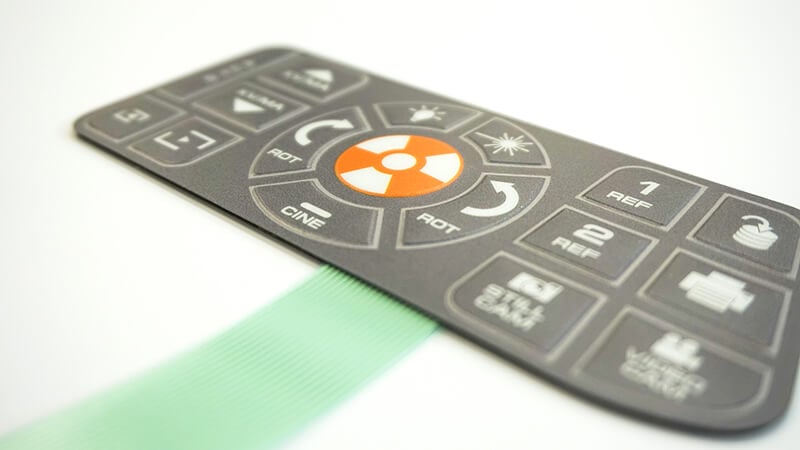Important Features to Look for When Picking a Membrane Switch
Wiki Article
Understanding the Capability of Membrane Switches for User Interface Instruments
The performance of membrane switches over stands for a substantial development in interface style, incorporating efficiency with aesthetic versatility. These switches operate with a multi-layered framework that translates individual interactions into electric signals, enabling both small formats and resilience versus ecological variables. As industries progressively focus on user experience, understanding the nuances of membrane button innovation comes to be necessary. What effects do these improvements hold for future applications, and exactly how might they redefine user interactions throughout numerous tools?What Are Membrane Layer Buttons?
Membrane switches are ingenious user interface tools that facilitate user interaction with digital tools. These flexible elements consist of numerous layers, including a visuals overlay, spacer, and a published circuit layer. The style permits a smooth integration right into different digital devices, enhancing both the aesthetic and functional aspects of interface.
Membrane buttons are commonly used in a wide variety of applications, from home devices to commercial machinery and clinical gadgets. Their building generally includes a thin profile, making them an ideal option for small designs. The responsive responses given by these switches can be engineered to meet specific customer choices, making certain reliable communication between the customer and the gadget.
Toughness is one more significant benefit of membrane switches, as they are immune to dust, dampness, and chemicals, which improves their lifespan popular atmospheres. Furthermore, these buttons can be tailored in terms of form, size, and visuals style, enabling branding and user-specific functions. On the whole, membrane changes represent a functional remedy for improving user experience in electronic tools, integrating performance with aesthetic allure in an efficient fashion.
Just How Membrane Changes Work
Operating on a straightforward concept, membrane layer changes utilize a split building and construction to register user input efficiently. Each button includes numerous layers, consisting of a printed circuit layer, a spacer layer, and a leading graphic layer, which are designed to interact effortlessly. When a user presses the top layer, it compresses the spacer layer, bringing the conductive elements of the circuit layer into contact with each other.This call creates a shut circuit, indicating the device to perform a specific function. The style permits for various setups, consisting of tactile comments, which can improve the customer experience by providing a physical feeling upon activation. The products made use of in membrane layer buttons commonly consist of adaptable substratums, such as polyester or polycarbonate, which make certain resilience and durability against wear and tear.

Key Benefits of Membrane Layer Buttons

One more significant benefit is their compactness. Membrane layer switches are slim and light-weight, which makes it possible for makers to conserve space in their tools without giving up performance. This feature is especially useful in applications where weight and quantity are crucial factors to consider.
Furthermore, membrane layer switches are resistant to dirt, moisture, and chemicals, boosting their durability. This strength extends their lifespan and lowers the requirement for constant replacements, leading to expense financial savings over time.
In addition, the tactile feedback supplied by membrane layer switches can be enhanced to boost individual interaction. They can include functions such as raised buttons or audible clicks, enhancing usability and individual experience.
Applications Throughout Industries
Interface gadgets using membrane layer buttons are prevalent in a broad variety of sectors, showcasing their adaptability and performance. Membrane Switch. In the medical industry, membrane layer buttons are essential to gadgets such as diagnostic devices and person monitoring systems, where their longevity and ease of cleaning are vital for keeping health standards. In the automotive industry, these switches are employed in control panel controls and infomercial systems, providing a sleek and modern user interface for users.Moreover, the customer electronic devices field gain from membrane switches in home appliances and handheld devices, where compact design and easy to use interfaces boost customer experience. Industrial applications also utilize membrane layer switches for control board in equipment and automation systems, stressing their effectiveness and resistance to extreme atmospheres.
In the aerospace and protection markets, membrane buttons are made use of in cabin controls and devices, where dependability and performance under extreme conditions are extremely important. Additionally, the gaming industry progressively integrates membrane layer buttons in controllers and game devices, adding to an interesting individual experience. In general, the flexibility of membrane layer switches allows their extensive usage throughout various sectors, emphasizing their relevance in modern interface style.
Future Trends in Membrane Layer Switch Over Technology

Additionally, using innovative materials, such as polycarbonate and polyester movies, is expected to rise, providing improved longevity and resistance to environmental stressors. These products add to the total longevity of membrane switches, making them suitable for harsher industrial applications.
In addition, the unification of wise modern technology, consisting of IoT pop over to this site connection, will make it possible for membrane buttons to communicate with other gadgets and systems, facilitating a more interactive individual experience. This pattern lines up with the expanding need for wise tools throughout numerous fields, from medical care to customer electronic devices.
Last but not least, customization options are anticipated to expand, allowing manufacturers to develop bespoke services tailored to particular individual needs More Bonuses and preferences. These developments will place membrane layer buttons as crucial parts in the development of interface modern technology.
Verdict
In conclusion, membrane layer switches represent a crucial improvement in customer interface innovation, supplying a trustworthy and versatile option for varied digital applications. As improvements in product science and touch noticing modern technologies continue, the performance and applicability of membrane layer switches are anticipated to increase, reinforcing their relevance in modern digital tools.
Report this wiki page